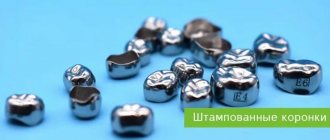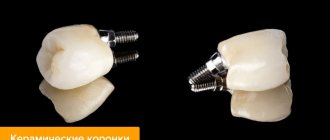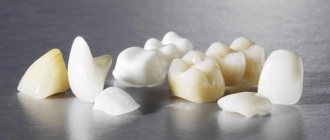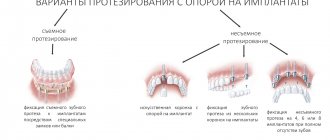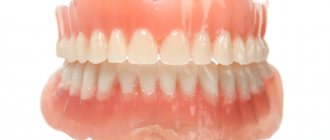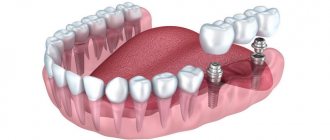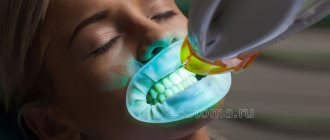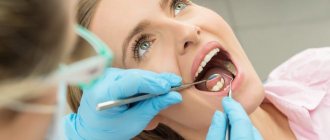- Indications
- Contraindications
- Advantages and disadvantages
- Kinds
- Clasp
- Made from nylon
- Lamellar
- Immediate dentures
- Manufacturing and installation
- Rehabilitation
- Care
- Prices
- Work examples
- Doctors
- Reviews
Despite the variety of implants, crowns and other methods of dental reconstruction, removable prosthetics does not lose demand, remaining an option for patients. Lightweight and strong structures compete with permanent dentures. This is a choice in cases where the patient cannot undergo implantation or have a fixed orthopedic system installed.
- When used:
missing from 1 tooth to completely edentulous - Type of anesthesia:
no need - Procedure time:
from 30 minutes (up to 4 visits) - Treatment period:
from 1.5 weeks to 3 weeks - Healing period:
from 3 weeks after the last removal - Age restrictions:
from 18 years old (in our clinic)
What dentures are best?
The type of system is selected individually. Taking into account the pros and cons of the designs, we draw the following conclusions:
- In case of partial loss of teeth and the presence of supporting teeth, clasp dentures will be an option. If there is an allergy to metals, choose QuattroTi dentures, acrylic, nylon models.
- If you have a toothless jaw, intolerance to acrylic and the impossibility of implantation, use plate Acry Free or nylon analogues.
Clasp dentures from 40,000 rub.
Nylon prostheses from 40,000 rub.
Lamellar dentures from 32,000 rub.
Butterfly prosthesis from 11,000 rub.
Quadrotti prosthesis from 64,500 rub.
Acri-Free prostheses from 47,000 rub.
Even with the same dental defects in two patients, prosthetics proceed differently. Only a doctor can tell which orthopedic product is the decision in this clinical situation, after examination and x-rays.
Partial dentures - reviews from specialists and patient opinions
In general, reviews of removable dentures from patients and doctors are positive. If there are contraindications to the installation of fixed structures, removable prosthetics are the only treatment option.
However, experts are confident that if there are no restrictions on implantation, the choice should be opted for prosthetics on implants. This option is the most preferable in terms of longevity, aesthetics, safety and prevention of bone atrophy.
Advantages and disadvantages
Advantages
- Restoring the aesthetics and functioning of the dentition;
- used in complex clinical situations when reconstruction methods are impossible;
- selection of types of orthopedic products;
- installation without preliminary grinding of abutment teeth;
- variability of materials for manufacturing;
- without restrictions;
- speed of production and installation;
- repair of the orthopedic system in case of mechanical damage;
- ease of wearing and care;
- exceptional hygiene and safety;
- no age restrictions;
- use as a temporary prosthetic structure;
- service life (5-8 years);
- preservation of aesthetic indicators;
- price.
Flaws
- Restoration of chewing function is not complete;
- changes in diction, taste sensitivity during the period of adaptation;
- the likelihood of gum inflammation, irritation of the oral mucosa;
- uneven distribution of chewing loads;
- unable to stop or prevent jawbone atrophy;
- not all types of dentures and fixtures can be repaired;
- risk of damage to tooth enamel, development of cervical caries in the area where the attachments adhere to the supporting ones;
- relatively long period of adaptation;
- deformation and subsidence of the product (for metal-free structures);
- insufficient fastening on the lower jaw (applies to complete removable dentures).
Types of removable denture systems
Removable dentures – orthopedic products. They are removed and installed in the oral cavity independently. Dentures are made from biocompatible, elastic materials. Two kinds:
- Partial removable - installed if the patient is missing one or more in a row. These are plate, clasp, and immediate dentures. They are attached to supporting teeth or implants with fixing elements. Evenly distribute the load when chewing between the supports and gums.
- Full removable – in case of loss of teeth on one or both jaws. In such situations, it is impossible to secure the denture to a rigid support. Alternative fixation is used. The chewing load is placed on the gums.
Modern technologies provide strong fixation and precise fit to removable orthopedic systems. Patients note the ease of use and care.
Cost of dental prosthetics on implants –
Of course, this is the best option for prosthetics, which will allow you not to grind down adjacent teeth for crowns (when replacing missing teeth with bridges), and will also protect you from a removable denture if most or complete absence of teeth. In this case, prosthetics are still carried out using artificial crowns and bridges, but only with the support of implants “implanted” into the jaw. There are several implantation techniques and many implant models, and different oral situations require completely different solutions.
The cost of a metal-ceramic bridge consisting of 3 crowns (to restore a single missing tooth) will cost you an average of 45,000 rubles, and this does not include the cost of preparing the teeth. In addition, after root canal filling, the teeth will be dead, i.e. more fragile and therefore will last less. With all this, implantation may not cost much more, considering that if one tooth is missing, you only need 1 implant + 1 crown (two teeth - 2 implants, three teeth in a row - most often 2 implants are also enough).
There are expensive dental implants such as Straumann or Nobel-Biocare (Switzerland), when the cost of installing one implant with a crown can be about 70,000 rubles and more. But there are also less expensive implants, for example, “MIS” (Israel), when installing 1 implant with a metal-ceramic crown in an economy class clinic will cost from 35,000 to 40,000 rubles. In any case, you should understand that it is better to install an inexpensive implant than to grind down adjacent healthy teeth for crowns.
An example of prosthetics on a dental implant –
Insert teeth on implants: price
Installation of 1 implant “MIS” or “AlfaBio” (with a metal-ceramic crown) will cost only 35,000 to 40,000 rubles. But if your budget allows, then you can choose Straumann, Astra Tech or Nobel Biocare implants, which will cost from 70,000 rubles for 1 implant with a metal-ceramic crown. Price, of course, matters, because... more expensive implant models perform better when implanted in areas with insufficient bone volume (this is especially important for achieving good gum aesthetics when implanted in the area of the front teeth).
Another feature of more expensive implant models is that they can often be used for prosthetics not 3-6 months after surgery, but already 2-6 weeks after installing the implant into the bone, and in some cases even immediately after surgery (in this case, first A temporary plastic crown is placed, which after the end of the healing period is replaced with a permanent one made of ceramics or metal-ceramics).
For more information about implantation methods and the rating of dental implants (for prosthetics with partial absence of teeth), read our review: Rating of dental implants in dentistry. There you will also find a detailed calculation of the cost of turnkey implantation, including the cost of different types of artificial crowns.
Prosthetics on implants in the absence of teeth –
1) Basal dental implantation – if you have a completely edentulous jaw and want a permanent bridge, you should definitely consider the basal implantation technique. This technique is characterized by less trauma, and also by the fact that prosthetics are performed within 2-3 days after surgery. Another plus is that the basal implants used for this technique allow you to avoid bone grafting in 90% of cases (even with severe atrophy of the jaws).
Prosthetics for one toothless jaw with basal implants will cost on average from 255,000 rubles turnkey (the price includes the installation of 8-10 basal-type implants and a fixed bridge prosthesis with cement fixation). If a modern screw fixation system is used, then the price will be about 350,000 rubles. The big advantage of this technique is that you will be able to chew “with your teeth” within 2-3 days after the operation (24stoma.ru).
Basal implantation: before and after photos
2) Implantation according to the All-on-4 protocol – thanks to the implantation method according to the All-on-4 protocol, you will also receive a completely permanent bridge within 2-3 days after surgery. The difference is that the bridge will be fixed on only 4 implants of a special design. The cost of prosthetics for 1 toothless jaw on a turnkey basis (including the installation of 4 original Nobel-Biocare implants and the cost of a bridge) will also be about 350,000 rubles.
All-on-4 on the lower jaw (before after photo) –
Clasp dentures
Clasp dentures are orthopedic structures made of artificial teeth on a base replicating natural gums, fixed on a durable metal arch (clasp). They correctly distribute the load when chewing without overloading the dental system. The condition for installing a clasp structure is a sufficient number of supports (teeth or implants) to which it is attached with hooks or clasps.
Removable dentures made of nylon
A base made of thin, elastic nylon on which artificial dental crowns are attached. Products are manufactured based on the clinical situation.
- The bioinert material does not contain metal impurities and does not cause allergies
, so the structures are not removed at night. - Since the color of the base is matched to the natural shade of the gums, the design is not noticeable and looks natural
.
Among the advantages are price, speed of adaptation, convenience. The only drawback of the design is that soft nylon sags and becomes deformed. But even so, the service life is 5-8 years
.
Other pros and cons of a nylon prosthesis
- Affordable price.
- Quite high aesthetic properties.
- Long-term preservation of the original shape and color when worn.
- Non-toxic material.
- No foreign odor in the mouth.
- Moisture resistant.
- Reduced quality of food processing.
- Some transparency of the material: teeth can be seen through the base at the junction.
- The appearance of cracks and scratches due to improper care.
- Periodic cleaning in laboratory conditions is recommended.
- Over time, the structure becomes deformed and requires replacement.
- Relatively short service life (this issue should be discussed carefully with your doctor).
Plate dentures
A group of prosthetic systems for partial or complete restoration. The basis of the structures is a soft base that imitates part of the oral mucosa, with artificial tooth crowns attached to it. Representatives of this group of orthopedic products are structures made from acrylic-free plastic alloy “Acry Free” and the elastic QuattroTi prosthesis.
- Partially removable QuattroTi
is an orthopedic system manufactured using 3D modeling technology. The approach ensures the fit of the structure and comfort of wearing. Elastic hook retainers do not require grinding of the supporting teeth, are invisible, and harmless to tooth enamel. - Lightweight, flexible Acry Free
made from non-allergenic composites combine appearance and comfort with service life (5 years) and price. Used for partial or complete restoration. The advantage of an orthopedic system is the ability to repair if damaged.
Made from bioinert materials, the flexible, soft base is not paintable and does not change color during service. They have a number of disadvantages, like similar orthopedic products.
Types of partially removable dentures
Plate made of plastic
Simple plastic structures are made from acrylic. The base in the form of a plate ensures adherence to the gums and fixation of the device. Additional fasteners (hooks) wrap around your own teeth.
- Pros: affordable price, quick production, aesthetics, possibility of repair or relocation.
- Disadvantages - low strength, unreliable fixation, porosity of the material (absorbs pigments, becomes covered with plaque), risk of allergies.
- Service life - 3-5 years.
Nylon
Nylon products are similar in design to plastic ones. When the base is accurately adjusted to the bed, the device fits tightly to the gums and holds well. Translucent hooks are not visible in the smile area.
- Pros: average price, aesthetics.
- Disadvantages - low resistance to stress, pain when chewing hard foods, chafing, deformation of the base, non-repairability.
- Service life - 1.5-2 years.
Akri Free
Removable jaws made of monomer-free plastic Acri-Free are durable and elastic at the same time. The base is adjusted to the gum, which ensures reliable fixation. Translucent fasteners are invisible to others. The design is resistant to loads, pressure, and deformation.
- Pros: durability, comfort for the patient, aesthetics, resistance to plaque accumulation, food coloring, hypoallergenic.
- The downside is that the price is higher than nylon and acrylic.
- Service life - 7-10 years.
Byugelny
Clasp-type products are equipped with a metal frame that passes through a plastic base. The parts of the structure are connected by an arc, which acts as a support and also increases the reliability of fixation. Additional fasteners in the form of metal hooks or locks attach the device to the supporting teeth. Clasp devices are recognized in dentistry as the optimal type of prosthesis for partially edentulous patients.
- Pros: reliable fixation, even distribution of load, can be used in case of periodontal disease or loose abutment teeth.
- Disadvantages - the price is higher, there is a risk of injury to soft tissues, they require getting used to, the clasps in the smile area are visible to others.
- Service life - from 7 years.
Quadrotti
Quadrotti products are similar in design to clasps. The main difference is the absence of metal elements. The false jaw is made from Italian-made Dental D material. The strength, stability, and elasticity of the polymer allow the false teeth to be made compact, with minimal overlap of the palate. Colorless fasteners are not visible in the smile area.
- Pros: minimal adaptation time, patient comfort, hypoallergenicity, aesthetics.
- Disadvantages: high cost, contraindicated for end defects.
- Service life - 5-7 years.
Sandwich without sky
The device consists of a compact plate base with artificial crowns. Fixation occurs due to a telescopic mechanism. The device is equipped with 2-4 dense crowns, which are placed on the patient’s own teeth like a cap.
- Pros: small size, secure attachment, compactness.
- Disadvantages: price, contraindicated in case of poor oral hygiene.
- Service life - 5-7 years.
Butterfly prosthesis
An immediate prosthesis or “butterfly” is equipped with a plastic or nylon base and one or more crowns. Attached with clasps on the sides of the structure.
- Pros: inexpensive, short production time, instant restoration of row integrity.
- Disadvantages - often break, unreliable fixation.
- Service life - devices for 1-3 crowns operate for 1-18 months.
Immediate dentures
Removable immediate dentures - to replace defects in the dentition during the production of a permanent orthopedic system. There are three types of such models - full, partial, butterfly.
They cope with the task, return partial work to a lost dental unit and hide a visual defect. The disadvantages include fragility, fragility, and long addiction.
Manufacturing and installation of a prosthesis
Includes stages:
- Preparatory and diagnostic – after hygienic cleaning, treatment, the patient undergoes a survey x-ray, CT scan of the jaw, which requires prosthetics.
- The dentist takes an impression and sends it to a dental laboratory.
- The production of an orthopedic system lasts on average 2 weeks. New technologies for taking impressions and 3D modeling make it possible to create anatomically verified structures that reproduce the chewing surface of each element down to the smallest detail.
- The doctor tries on the finished denture for the patient and corrects any discrepancies.
The final stage is fixation of the product in the oral cavity.
Fixation of prostheses
Bugel, partial and full plate systems are attached to the mouth in different ways. Clasp ones are held in place with the help of clasps and attachments, partial plate ones - with soft fasteners, full plate ones - with a vacuum effect.
- Clasps
are metal hooks with which the prosthetic system clings to the base of the support units. - Attachments
are locks made of two components. One component is located on the prosthetic structure. The second is on the supporting tooth or implant. When putting on the orthopedic system, the clasp snaps tightly into place, holding the product in the mouth. - Vacuum effect
- flexible material fits closely to the gums and sticks to them. If necessary, increase the tightness of the seal, use “adhesive” pastes and gels.
Removable dentures are created using impressions from the patient. They are fixed in the mouth and do not fall out when chewing or playing sports.
Alekperov Roman Borisovich Dentist-orthopedist, doctor of the highest category
Is it necessary to remove a single tooth when performing removable dentures?
When talking about removable dental prosthetics of the lower jaw, they try to preserve their own teeth as much as possible. When replacing dentures in the upper jaw, single teeth must be removed. The decision is made by the doctor based on the clinical situation, after examination and diagnostic measures.
Alekperov Roman Borisovich Dentist-orthopedist, doctor of the highest category
There is only one tooth left on the upper jaw. Which denture should I choose so that the structure is held as tightly as possible and does not fall off?
If there is a single tooth in the upper jaw, only a partial, removable plate prosthetic system is likely to be manufactured. But such a design will not hold very firmly and in terms of reliability of fixation it is significantly inferior to prosthetics on implants. As an alternative, we recommend All-on-4, in which the denture is securely fixed to the jaw using only 4 titanium supports.
Alekperov Roman Borisovich Dentist-orthopedist, doctor of the highest category
On the left side of the upper jaw, 4 teeth in a row were lost. There are gold crowns on the lower jaw. Which removable denture is best placed on the upper jaw so that it does not conflict with the crowns?
In this case, it is possible to manufacture a partial removable lamellar denture based on acrylic or an Akri Free prosthesis. It is also possible to install the prosthesis on attachments or telescopic crowns. Since metal crowns are already present in the oral cavity, the best option would be Akri Free prosthetics.
Prosthetics with artificial crowns and bridges –
Many different materials are used to make crowns, differing in strength and aesthetic properties. Therefore, if you decide to insert teeth, the price of crowns made of different materials will differ markedly from each other. Most often, artificial crowns are made from metal ceramics (when the internal metal frame is lined with ceramic mass), or from metal-free ceramics - porcelain, zirconium dioxide, or lithium disilicate.
For fixed dental prosthetics, the prices below will be indicated for 2021 (prices are indicated for clinics in the middle price category).
Cost of dental prosthetics with metal-ceramics –
Can be used for prosthetics of both anterior and chewing teeth. They have an affordable cost and acceptable aesthetics (although it is clear that their aesthetics will be inferior to the aesthetics of crowns made of metal-free ceramics). For the restoration of front teeth, metal-ceramics is not suitable for all patients, and the important point is that in some people the enamel of the front teeth has a high coefficient of transparency, in others it is almost opaque.
A metal-ceramic crown under a layer of ceramic has a metal frame that prevents the passage of light, which means such crowns will be completely opaque. Therefore, if you have high enamel transparency and if you only need to restore single front teeth, this can lead to the fact that the restored tooth will be very different from the neighboring healthy teeth. But when using prosthetics for chewing teeth, the issue of aesthetics is no longer so important.
Metal-ceramic dental prosthetics: before and after photos
In addition, metal ceramics can be very different in quality, and the cost range for 1 crown can be from 5,500 to 16,000 rubles. The difference in price depends not only on the quality of the metal used for the metal frame, but also on the ceramic mass (for example, cheap ceramic mass will definitely mean poor aesthetics, as well as a higher risk of chipping the ceramic). The most important point will be to take into account the crown manufacturing technology.
For example, in addition to traditional metal-ceramics, there is also the so-called metal-ceramics with shoulder mass, which allows you to achieve good aesthetics of the gums around the crown. After all, the main disadvantage of traditional metal-ceramic crowns is not only their complete opacity, but also the fact that they give a pronounced bluish appearance to the gums, which looks very unsightly when smiling. Therefore, if you want to restore your front teeth, it is better to choose metal-ceramics with shoulder mass (more details in the link above).
Dental prosthetics with metal-ceramics: prices
1) The cost of 1 unit of metal ceramics on a cast metal frame made of a traditional cobalt-chromium alloy using inexpensive ceramic mass such as “Duceram” (Germany) will cost about 12,000 rubles. If a higher quality ceramic mass is used on the same frame - this could be “Noritake” (Japan), “Vita” (Germany) or “Ivoclar” (Liechtenstein), then the price will range from 15,000 rubles to 18,000 for 1 crown .
At the same time, if the crown is made with the so-called “shoulder mass”, then add approximately another 5,000 rubles to the prices indicated above.
2) If the metal frame is made not by casting, but by milling on a computer-controlled machine (using CAD\CAM technology), then the cost of 1 crown will be about 20,000 rubles. This method of making a frame will make it possible for the crown to fit as closely as possible to the tissues of the tooth in the area of its neck. This is the most important guarantee that the crown will last as long as possible.
3) The cost of one unit of metal ceramics on a gold-platinum alloy is from 25,000 rubles. The use of noble metal alloys is necessary for some patients who are allergic to traditional metal alloys. It is also better than cobalt-chromium alloy in terms of aesthetics, because... gold will give the ceramic mass a natural tint, which is characteristic of natural tooth enamel. At the same time, you must take into account that the cost of dental gold will be added to this cost (+ 5,000 rubles per 1 gram).
4) When making temporary crowns from plastic (they are made so that the patient does not have to wear his teeth ground down for about 2-3 weeks while permanent crowns are being made), the cost of the work will increase by another 1,500 rubles (for each plastic crown).
Important: prices for such dental prosthetics can be lower, for example, you can probably find such crowns for 6,000-8,000 rubles. At such low prices, only the most inexperienced dental technicians will make crowns in a dental laboratory, and the crowns themselves will most likely be made from Belarusian or Russian materials (metal, ceramic mass), which is fraught with:
not very good or downright bad aesthetics,- cracks in the metal frame,
- chipped ceramics.
If you want crowns to be indistinguishable from neighboring healthy teeth and to serve you for 8-10 years, then you should not look for the lowest price (otherwise they will look no better than in Fig. 4). For example, the crowns in Fig. 4 objectively cannot cost more than 6,500 rubles for 1 crown, because their color is frankly bad, and there is no transparency even along the cutting edge, where there is no metal frame. But unfortunately, this quality of work in Russia is rather the norm. But the much more aesthetic crowns in Fig. 5 should cost about 15,000 rubles per unit.
Price of prosthetics with ceramic crowns –
Ceramics for artificial crowns and bridges can be of several types. The simplest and most inexpensive option, which is only suitable for restoring severely damaged crowns of front teeth, is feldspathic ceramics (porcelain). It is undesirable to make porcelain crowns on chewing teeth due to their low strength, and as a result, this type of ceramic is completely unsuitable for the manufacture of bridges. Thus, the good aesthetics of porcelain are combined with its low reliability.
The second option is ceramic crowns made of a material such as zirconium dioxide. In the manufacture of these crowns, modern milling technology is used on a computer-controlled machine (CAD/CAM technology). Moreover, zirconium crowns can be made either entirely from monolithic zirconium dioxide, or have only a frame milled from zirconium, which will be covered on the outside with layers of ceramic mass. This prosthetic option is best used if you need crowns in the area of chewing teeth, or extended bridges more than 3 units long.
The third and best option is IPS E.max glass ceramics. Crowns made from this material have the best aesthetics, but also have high strength. If you need to restore single damaged front teeth with crowns, then it is best to choose E.max ceramics (Fig. 7-8). But this material also has one important limitation - it can be used to make bridges no more than 3 units long, and only in the area of the front teeth.
Dental prosthetics: before and after photos
How much does it cost to insert a ceramic tooth?
Taking into account the different types of metal-free ceramics that can be used for dental prosthetics, the cost indicated for 1 crown can range from 18,000 to 30,000 (in economy class and mid-price clinics). See below for more details.
1) One crown made of zirconium dioxide will cost in Moscow from 30,000 rubles (+ 2,000 rubles will have to be paid for a temporary crown made of plastic). In the regions of Russia, the cost will be slightly lower and can range from 25,000 rubles.
2) The cost in Moscow of one glass-ceramic crown IPS E.max will depend on the material option. If the crown was made by pressing from the E.max PRESS material, the price will be from 25,000 rubles. If the crown was made by milling using CAD/CAM technology from E.max CAD material, the price will start from 30,000 rubles. Plus 2000 rubles in both cases you will have to pay for a temporary plastic crown. It should be noted that in the regions of Russia prices will be lower (from 20,000 rubles for 1 crown from E.max PRESS).
3) Ceramic crowns made of porcelain (feldspathic ceramics) have the most affordable price. They, like Emax, also have excellent aesthetics, but have less strength and reliability, and therefore, if you choose them, it will only be for restoring partially destroyed crowns of the front teeth (making a bridge or installing a crown on chewing teeth will not be possible). The price of one such crown will be around 15,000 rubles.
Important: sometimes in advertising you can see prices for ceramic crowns of about 10,000 rubles. This can only mean that such crowns will most likely be made from cheap ceramic mass made in China or Russia. But if for crowns made of porcelain the price of 10,000 rubles is still somehow comprehensible (provided that the cheapest materials are used), then for crowns made of zirconium dioxide or Emax ceramics - the price a priori cannot be lower than 23,000 and 16,000 rubles , accordingly, even in clinics of the lowest price segment!
Price for prosthetics with metal crowns –
These crowns are different in that they are made entirely of metal and, accordingly, their aesthetics will tend to zero. But in principle, this may not be so important if you are replacing distant chewing teeth that will not be visible when you smile. Such crowns, by the way, have a tangible advantage - the teeth under them require much less grinding than under metal-ceramics. This means that more tooth structure will remain under the crown, which means the crown can last longer.
It is best when metal crowns are made by casting - which is why they are called “solid” (Fig. 9). The cost of dental prosthetics with such solid-cast crowns will range from 5,000 to 6,000 rubles per unit. The worst option for metal crowns is crowns stamped from steel sleeves, which are then sprayed (such crowns are still made in remote regions of Russia at state clinics).
How to quickly get used to a removable prosthetic system?
After installing a denture, it will take time to get used to it. To ensure that adaptation proceeds without problems, we recommend:
- Do not remove from mouth for long;
- suck on lollipops to suppress the feeling of nausea;
- read aloud to practice clear diction;
- For the first few days, follow a gentle diet.
Addiction lasts on average 2-4 weeks. If discomfort persists for more than a month, pain intensifies, gums become inflamed and bleed, you should consult a doctor.
Caring for dentures
They are not difficult to care for. All that is needed:
- Clean morning and evening with a soft brush and pastes that do not contain abrasives;
- rinse your mouth every time after eating;
- regularly treat with an antiseptic;
- give up sticky (chewing gum, toffee), excessively hard foods (nuts);
- Once every six months, take the denture to an orthopedist for cleaning and correction.
Compliance with these simple rules extends the service life and preserves the original appearance of dentures.
Article Expert
Alekperov Roman Borisovich Dentist-orthopedist, doctor of the highest category
Work experience: more than 32 years
Prices
Free online consultation with a dentist
| Service | Price |
| Removable and conditionally removable prosthetics | from 6,500 rub. |
| Installation of a temporary cosmetic plate (butterfly) | from 11,000 rub. |
| Installation of a complete or partially removable lamellar denture (acrylic, 1 jaw) | from 32,000 rub. |
| Installation of a clasp denture with clasps (1 jaw) | from 40,000 rub. |
| Installation of a partially removable nylon prosthesis (1 jaw) | from 40,000 rub. |
| Installation of a complete removable denture Akri Free (1 jaw) | from 47,000 rub. |
| Installation of a splinting clasp prosthesis (1 jaw) | from 55,000 rub. |
| Installation of a partially removable clasp prosthesis Quadrotti (1 jaw) | from 64,500 rub. |
| Installation of a locking clasp prosthesis (1 jaw) | from 70,000 rub. |
| Installation of a clasp denture on telescopic crowns (1 jaw) | from 75,000 rub. |
| Conditionally removable acrylic prosthesis on spherical attachments Rhein-83 for 1 jaw | from 121,000 rub. |
Consultation and diagnostics are free!
All prices Promotions
Modern materials
Removable acrylic dentures
Budget option based on polymers. Conventional plastic dentures strongly rub the gums and do not fit well. However, our laboratory specialists use a special formula - a new generation acrylic prosthesis, with the addition of crushed diamond chips. The design is more resistant to chewing loads, comfortable to wear and has an aesthetic appearance, and also provides a longer service life.
Elastic
These can be soft nylon or thin removable dentures made of acrylic resins (Acry Free). The material adheres tightly to the gum tissue in the oral cavity. Does not cause pain or discomfort. Can be used for bruxism.
Who is suitable for nylon prostheses?
The use of removable nylon dentures is acceptable in the absence of one or several teeth. The products are used in cases of lack of extreme, lateral or front teeth in a row and even in cases of complete edentia. Edentia is commonly understood as the absence of all teeth in a row or jaw. The use of removable dentures made of nylon is possible for sensitive and weak gums, as well as for restoring dentition in children. Such orthopedic products do not contain metal compounds and are excellent for patients with allergic reactions. As for nylon itself, it is absolutely hypoallergenic.
With locks (sandwich dentures)
Installation requires two healthy tooth roots. One part of the lock is attached to the dental bridge, the second (abutment) is fixed in the root of the tooth. The prosthesis does not have a septum in the palate, which ensures maximum taste sensitivity. Thanks to the partial overlap, the removable denture can be worn for several days, only being removed for cleaning.
Dentures on implants
The most popular type of prosthesis. It is securely attached to the gum due to four supports connected to each other by a beam. Removable dentures on implants provide an even load on the jawbone, and the absence of a palate in the structure guarantees a natural taste perception when eating. It is easy to use, has a long service life and can be easily replaced with a new one if necessary. The only drawback is the high cost of installation due to the materials used. However, the price is fully justified by the quality, comfort and durability of the product.
Clasp dentures
This type of prosthesis is suitable for complete and partial restorations. Due to its aesthetics and affordable price, removable clasp dentures are in high demand among patients in dental clinics.
When making a removable clasp denture, specialists use a base made of elastic plastic, to which a metal beam is attached. Dental crowns made of artificial materials are fixed on the latter. Depending on the type of structure and the wishes of the patient, crowns on a dental bridge can be made of plastic, metal or metal-ceramics.
A partially removable denture is attached using clasp hooks if there are native supporting teeth. Or it could be a hidden mechanism that connects the crown to the base of the tooth. The clasp bridge is easy to use - it does not need to be removed before going to bed.
Work examples
All works
Partial removable denture for chewing teeth
Restoration of both jaws with removable acrylic dentures
Conditionally removable prosthesis using a fastening system on Rhein-83 attachments
All works
Sign up for a consultation
three ROOTT specialists + diagnostics as a gift
Glue and cream for fixing removable dentures
Models with suction cups sometimes require additional fixation. For this purpose, special fixing gels, adhesives and strips are produced. The decision on the use of such means is made by the orthopedist, who also selects the most suitable means and teaches the patient how to use it. The most popular means for fixation:
- Protefix (manufacturer: Queisser Pharma, Germany) – fixing cream with a strong immediate effect lasting from 8 to 12 hours; the price of a 47 g tube is about 230 rubles;
- Rox (BONYF, Liechtenstein) – fixing cream, lasts at least 12 hours, price about 250 rubles;
- Fittydent (FittyDent International, Austria) - considered one of the best fixation creams, lasts 12 hours, price for a 40 g tube is about 250 rubles.
Means for fixing prostheses
When using fixative creams, they must be applied strictly in accordance with the instructions. Most creams are used like this:
- Rinse and dry the structure.
- Apply a little cream to the surface of the removable denture attached to the tissue.
- Rinse your mouth.
- Place the removable denture on the jaw and bite hard for 5–6 seconds.
Instructions for use of fixing creams

